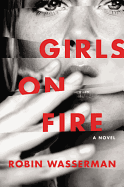
Young adult fiction author Robin Wasserman's first novel for adults, Girls on Fire, has a lot in common with YA literature. The story features protagonists in high school, intense emotions and a mystery that doesn't fully unravel until the final pages. Girls on Fire, however, pushes young adult tropes into decidedly adult territory, cranking the emotional intensity higher and higher while pushing events into truly shocking, subversive territory. Much like her young protagonists, Wasserman takes things shockingly far, creating an irresistible hybrid between coming-of-age stories and Gone Girl-esque psychological thrillers.
Girls on Fire takes place in the early '90s, when grunge was breaking through at the same time Satanic panic was reaching its height. The conservative community of Battle Creek, including mousy protagonist Hannah Dexter, is unsettled by the unexplained suicide of a popular high schooler. Lacey Champlain, a troubled young grunger, forms a fierce bond with Hannah and sets about remaking the naïve, directionless girl in her own image. Suffice it to say that archconservative Christianity, transgressive sexuality and disturbing secrets all play their role in the ensuing events.
Girls on Fire is aware of the strange dichotomy of youth: it's both the best time to be alive and the absolute worst. Wasserman also extends her sympathy to the adults, who "felt, at times, that what had seemed like an infinity of choice turned out to be a funnel." The focus of the story, however, is always on the girls and the dangerous, dying-star intensity of their love for each other. --Hank Stephenson, bookseller, Flyleaf Books

